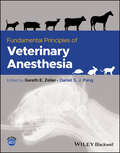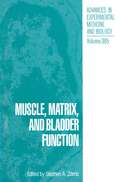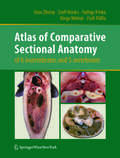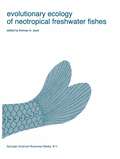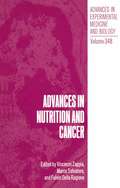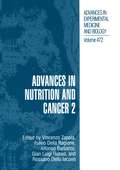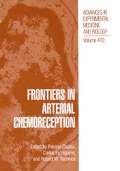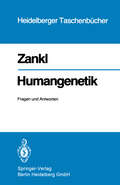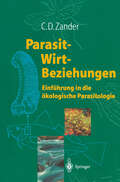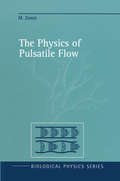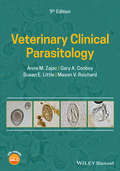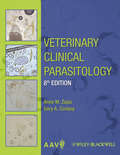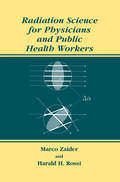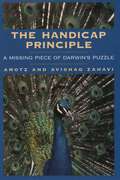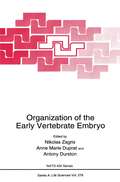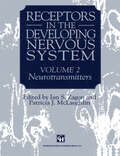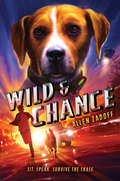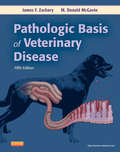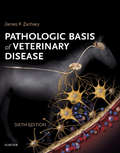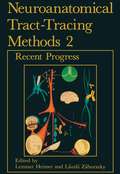- Table View
- List View
Fundamental Principles of Veterinary Anesthesia
by Gareth E. Zeiler Daniel S. J. PangFundamental Principles of Veterinary Anesthesia Comprehensive textbook integrating physiology and anesthesia of multiple species of animals in a unique practical setting Fundamental Principles of Veterinary Anesthesia is designed specifically for veterinary students, animal health technicians and veterinarians in general practice. The first edition of Fundamental Principles of Veterinary Anesthesia covers the key principles of veterinary anesthesia, encompassing a wide range of species, including dogs, cats, horses, cattle, and pigs, and establishing links between physiology, pharmacology, and clinical practice in healthy and ill patients. This text serves as a practical guide for students to prepare themselves for clinical work in a private practice setting, and as a rich, practical resource for those in general practice. This text is ideally used as a complete curriculum aligned resource, and the companion website is designed to decrease the burden of lecturers who need to compile PowerPoint presentations and review questions. Topics covered in Fundamental Principles of Veterinary Anesthesia include: Practical approaches to the peri-anesthetic period, from patient assessment, through to preparing for, and successfully completing, an anesthetic event Anesthetic drugs available in an academic or private practice, with a focus on commonly used drugs Components of the anesthetic machine, gas flow through the machine, how vaporizers work and their functionalities Principles and techniques of patient monitoring, with a focus on commonly available devices and their applications
Fundamental Principles of Veterinary Anesthesia
by Gareth E. Zeiler Daniel S. PangFundamental Principles of Veterinary Anesthesia Comprehensive textbook integrating physiology and anesthesia of multiple species of animals in a unique practical setting Fundamental Principles of Veterinary Anesthesia is designed specifically for veterinary students, animal health technicians and veterinarians in general practice. The first edition of Fundamental Principles of Veterinary Anesthesia covers the key principles of veterinary anesthesia, encompassing a wide range of species, including dogs, cats, horses, cattle, and pigs, and establishing links between physiology, pharmacology, and clinical practice in healthy and ill patients. This text serves as a practical guide for students to prepare themselves for clinical work in a private practice setting, and as a rich, practical resource for those in general practice. This text is ideally used as a complete curriculum aligned resource, and the companion website is designed to decrease the burden of lecturers who need to compile PowerPoint presentations and review questions. Topics covered in Fundamental Principles of Veterinary Anesthesia include: Practical approaches to the peri-anesthetic period, from patient assessment, through to preparing for, and successfully completing, an anesthetic event Anesthetic drugs available in an academic or private practice, with a focus on commonly used drugs Components of the anesthetic machine, gas flow through the machine, how vaporizers work and their functionalities Principles and techniques of patient monitoring, with a focus on commonly available devices and their applications
Muscle, Matrix, and Bladder Function (Advances in Experimental Medicine and Biology #385)
by Stephen A. ZdericThis conference and monograph were the result of many collective efforts. The whole concept was formulated one early Wednesday morning at our weekly research meeting at Children's Hospital in our division of urology. We have been most fortunate to have a close collaboration with Bob Levin, Ed Macarak, and Pam Howard who have helped steer the course of our division's growing interest in basic science. At our weekly meetings our laboratory fellow will summarize their current work. Other ongoing areas of investigation in our labs and elsewhere are discussed. We have always made an effort to try and understand what other groups are doing who are working in the area of bladder smooth muscle research. It occurred to us that the best way to really know what everyone working in this field was doing would be to sponsor a 2-day meeting where we could all gather to discuss our ongoing work. A major limitation of the annual meeting of the American Urologic Association or the urology section of the American Academy of Pediatrics is that the scientfic sessions are limited as these are meant to be primarily clinical meetings (as they should be). For this reason the idea of a meeting devoted solely to research about the urinary bladder had great appeal. In addition to allowing for longer presentations than the standard 5 to 7 minutes, every effort would be made to encourage a dialogue amongst the presenters and the audience.
Atlas of Comparative Sectional Anatomy of 6 invertebrates and 5 vertebrates
by Géza Zboray Zsolt Kovács György Kriska Kinga Molnár Zsolt PálfiaThis atlas contains 189 coloured images taken from transversal, horizontal and sagittal sections of eleven organisms widely used in university teaching. Six invertebrate and five vertebrate species – from the nematode worm (Ascaris suum) to mammals (Rattus norvegicus) – are shown in detailed images.Studying the macrosections with unaided eyes, with a simple magnifier or binocular microscope might be of great help to accomplish traditional anatomical studies and to establish a certain spatial experience/space perception.This volume will be of great interest for biology students, researchers and teachers of comparative anatomy. It might act as supporting material of practical courses. Furthermore, medical practitioners, agricultural specialists and researchers having an interest in comparative anatomy might also benefit from it.
If You Go with Your Goat to Vote
by Jan ZauzmerWith their adorable babies in tow, an eclectic menagerie of animals visit the polls and vote—teaching young readers how voting works, and reminding grown-ups to model civic engagement for the next generation
Evolutionary Ecology of Neotropical Freshwater Fishes (Developments in Environmental Biology of Fishes #3)
by T. M. ZaretIn August of 1980, near the whistlestop of Maltby, Surely, we would plead, the U. S. A. , a wealthy Washington, Don Stewart and I met in my rented nation,can fund our proposal if only as a gesture of house trailer to sketch a proposal to the National support to foreign scientists. Somehow, however, Science Foundation. Our goal was simple: to re we seemed to miss deadlines, fall in-between the quest from the Foundation air fare and per diem for cracks, and miss the right connections. It was not approximately 20 Latin American scientists to at until May, 1982, several weeks before the proposed tend a workshop entitled the 'Systematics and workshop, that we realized we could not find any Evolutionary Ecology of Neotropical Freshwater funds for bringing Latin American scientists to the Fishes' that would follow the 1982 ASIH (Ameri U. S. The programs for the meeting had been can Society of Ichthyologists and Herpetologists) printed, the meal coupons, banquet tickets, and all meeting. We had presented an initial outline for our the other amenities that come with a professional proposal to a number ofcolleagues in . June of 1980 meeting were ready, but we had no Latin American at the ASIH meeting at Texas Christian University ichthyologists as participants. Some abstracts were in Fort Worth, Texas. The steering committee for being received by the program organizers, but the workshop, consisting of a dozen senior scien without U. S.
Advances in Nutrition and Cancer (Advances in Experimental Medicine and Biology #348)
by Vincenzo Zappia Marco Salvatore Fulvio Della RagioneThis volume contains the scientific contributions presented at the International Symposium held in Naples, Italy, in November 1992 at the National Tumor Institute "Fondazione Pascale". The Meeting gathered together experts from different disciplines, all involved in the vital and timely subject of Nutrition and Cancer. About 15 years ago a consensus among cancer epidemiologists began to emerge suggesting that diet might be responsible for 30-60% of the cancers in the developed world. The best estimate, reported in a now classical paper by Richard Doll and Richard Peto (1981), was that by dietary modification, it would be possible to reduce fatal cancers by about 35%. Within about six years there was widespread agreement that the principal changes required were a reduction in consumption of fat, along with an increase in the consumption of fruit, green and yellow vegetables, dietary fiber, and some micronutrients. Attention was also paid to the methods of cooking and preservation of foodstuffs. On the other hand very few, if any, effects were attributed to food additives and to pollution of food by trace pesticides, to which the general public often gives unfounded importance.
Advances in Nutrition and Cancer 2 (Advances in Experimental Medicine and Biology #472)
by Vincenzo ZappiaThis volume includes contributions presented at the Second International Sym posium on Nutrition and Cancer, held in Naples, Italy, in October 1998 at the National Tumor Institute "Fondazione Pascale." During the Conference, experts from different disciplines discussed pivotal and timely subjects on the interactions between human nutrition and the development of malignancies. Comparing the themes of this Meeting with those discussed at the First Sympo sium in 1992, the major scientific advancements certainly derive from the extensive use of molecular approaches to perform research in nutrition. Moreover, the fundamental observation of R. Doll and R. Peto (1981), which suggested that at least 35% of all cancers (with large differences among different tumors) might be prevented by dietary regimens, has been definitively confirmed by epidemiological studies. On the other hand, the relationships between diet and cancer are quite intricate and complex; it is difficult, and at the same time not methodologically correct, to reduce them to simple terms. Metabolic and hormonal factors, contaminants and biological agents, and deficiency of specific protective nutrients are all pieces of the same puzzle.
Frontiers in Arterial Chemoreception (Advances in Experimental Medicine and Biology #410)
by Patricio Zapata Carlos Eyzaguirre Robert W. TorranceProceedings of the XIIIth International Symposium, held in Santiago, Chile, March 25-29, 1996
Humangenetik: Fragen und Antworten (Heidelberger Taschenbücher #207)
by Heinrich ZanklDie Humangenetik gehört zu den "kleinen Fächern", denen die Medizinstudenten bei ihrer Vorbereitung auf den 1. Abschnitt der ärztlichen Prüfung bisher nur wenig Beachtung geschenkt haben. Durch die Verschärfung der Prüfungsbedingungen ist es jedoch not wendig geworden, sich auch auf dieses Fach intensiv vorzubereiten. Da es nicht möglich ist, kurz vor der Prüfung ganze Lehrbücher durchzuarbeiten, erschien es sinnvoll, einen Text zur Verfügung zu stellen, der ohne großen Zeitaufwand mit den für die Prüfung wichtigsten Themen vertraut macht. Das vorliegende Büchlein ist aus einem Seminar für Prüfungskandidaten hervorgegangen, das sich bei den Studenten großer Beliebtheit erfreut. Durch die Orientierung des Textes an einzelnen Fragen hat der Student Gelegenheit, die Prüfungssituation zu simulieren und sein Wissen zu kontrollieren. Die Antworten wurden so umfassend gestaltet, daß klar wird, warum eine bestimmte Antwort richtig ist und daß auch andere Fragen zum gleichen Themenkreis beantwortet werden können. Soweit notwen dig, wurde auch auf Unklarheiten und bewußte Fallen in der Fragestellung hingewiesen, um den Blick der Studenten für solche Prüfungserschwernisse zu schärfen.
Parasit-Wirt-Beziehungen: Einführung in die ökologische Parasitologie
by C. Dieter ZanderParasiten sind uns nicht angenehm, denn sie leben auf Kosten anderer. Betrachtet man aber den Wirtsorganismus als enge ökologische Nische, so findet man faszinierende Anpassungen an den Lebensraum in und auf einem fremden Lebewesen. Diese vielfältigen Überlebensstrategien mußten auch Parasiten im Laufe der Evolution entwickeln. Einige Arten sind in verschiedenen Stadien ihres Lebenszyklus auf ganz spezielle Wirtsorganismen angewiesen. Nie dürfen sie ihren Wirt so schädigen, daß er daran zugrunde geht. Auch unter den verschiedenen Parasitenpopulationen und -gemeinschaften gibt es Konkurrenz. Diese komplexen Parasit-Wirt-Beziehungen beschreibt der Autor, Dieter Zander, in anschaulicher Weise.
The Physics of Pulsatile Flow (Biological and Medical Physics, Biomedical Engineering)
by M. ZamirA presentation of the most elementary form of pulsatile flow as an important prerequisite for the study of other flow applications in biological systems. The book provides in a single source a complete treatment of the fluid dynamics of flow with the required mathematics and emphasis on the basis mechanics. The style and level of this book make it accessible to students and researchers in biophysics, biology, medicine, bioengineering and applied mathematics working in theoretical and clinical work on the cardiovascular system, as well as in the design of new instrumentation, medical imaging systems, and artificial organs. With problems and exercises.
Veterinary Clinical Parasitology
by Anne M. Zajac Gary A. Conboy Susan E. Little Mason V. ReichardNew edition of the market-leading benchtop reference on the diagnosis of internal and external parasites in animals, including expanded coverage of parasites of reptiles, birds, and other exotic species Veterinary Clinical Parasitology, 9th Edition, allows for a quick and accurate reference to internal and external parasites found in a wide variety of domestic animals and laboratory animal host species. Focusing on the tests and information most relevant to daily veterinary practice, this classic benchtop manual contains a wealth of high-quality images to assist readers in diagnosing parasitic disease and identifying and treating relevant parasites. Contributions by leading experts in veterinary pathobiology and parasitology cover fecal examination for the diagnosis of parasitism, detection of parasites in the blood, diagnosis of arthropod parasites, and more. The latest edition contains fully revised material throughout, including new and expanded information on immunodiagnostic and molecular diagnostic tests, additional parasite-specific material on the benefits and limitations of different test modalities, and increased coverage of reptiles, birds, and other exotic and laboratory animals. New sections include up-to-date information on anthelmintics, antiprotozoals, and other antiparasitic drugs, and challenging case studies that provide insights on situations where identification of parasites is especially difficult. Published under the auspices of the American Association of Veterinary Parasitologists (AAVP), this indispensable clinical manual: Describes accurate and cost-effective techniques for diagnosing parasitic infections in animals Presents clear and concise information on the distribution, life cycle, and significance of each parasite covered Contains hundreds of color clinical images to enable rapid picture-matching and aid in diagnosis Offers a spiral-bound format that allows the book to lie flat on the benchtop, ideal for regular use in daily practice Features revised content throughout, including new chapters and images, an improved format, an enhanced color scheme, and an updated companion website Veterinary Clinical Parasitology, 9th Edition is an essential resource for practicing veterinarians, veterinary technicians, diagnosticians, researchers, and students in need of a timely and efficient reference on morphologic identification of parasites in different animal species.
Veterinary Clinical Parasitology
by Anne M. Zajac Gary A. Conboy Susan E. Little Mason V. ReichardNew edition of the market-leading benchtop reference on the diagnosis of internal and external parasites in animals, including expanded coverage of parasites of reptiles, birds, and other exotic species Veterinary Clinical Parasitology, 9th Edition, allows for a quick and accurate reference to internal and external parasites found in a wide variety of domestic animals and laboratory animal host species. Focusing on the tests and information most relevant to daily veterinary practice, this classic benchtop manual contains a wealth of high-quality images to assist readers in diagnosing parasitic disease and identifying and treating relevant parasites. Contributions by leading experts in veterinary pathobiology and parasitology cover fecal examination for the diagnosis of parasitism, detection of parasites in the blood, diagnosis of arthropod parasites, and more. The latest edition contains fully revised material throughout, including new and expanded information on immunodiagnostic and molecular diagnostic tests, additional parasite-specific material on the benefits and limitations of different test modalities, and increased coverage of reptiles, birds, and other exotic and laboratory animals. New sections include up-to-date information on anthelmintics, antiprotozoals, and other antiparasitic drugs, and challenging case studies that provide insights on situations where identification of parasites is especially difficult. Published under the auspices of the American Association of Veterinary Parasitologists (AAVP), this indispensable clinical manual: Describes accurate and cost-effective techniques for diagnosing parasitic infections in animals Presents clear and concise information on the distribution, life cycle, and significance of each parasite covered Contains hundreds of color clinical images to enable rapid picture-matching and aid in diagnosis Offers a spiral-bound format that allows the book to lie flat on the benchtop, ideal for regular use in daily practice Features revised content throughout, including new chapters and images, an improved format, an enhanced color scheme, and an updated companion website Veterinary Clinical Parasitology, 9th Edition is an essential resource for practicing veterinarians, veterinary technicians, diagnosticians, researchers, and students in need of a timely and efficient reference on morphologic identification of parasites in different animal species.
Veterinary Clinical Parasitology (Veterinary Clinical Parasitology Ser.)
by Anne M. Zajac Gary A. ConboyVeterinary Clinical Parasitology, Eighth Edition, prepared under the auspices of the American Association of Veterinary Parasitologists (AAVP), emphasizes the morphologic identification of both internal and external parasites of domestic animals. Focusing on the tests and information most relevant to daily practice, the book describes accurate, cost-effective techniques for diagnosing parasitic infections in animals. Including clear, easy-to-find information on the distribution, life cycle, and importance of each parasite, Veterinary Clinical Parasitology offers more than 450 images to aid with diagnosis. The Eighth Edition includes a new chapter on immunologic and molecular diagnosis, increased coverage of ticks and new sections on identification of microfilariae and larvae in diagnostic samples. The new edition also features expanded information on quantitative egg counts, detection of anthelmintic resistance and identification of ruminant strongylid larvae. Additional improvements include many new images throughout the book, revised taxonomic information, a new layout featuring tabs by section to improve user-friendliness, and a companion website offering the images from the book in PowerPoint at www.wiley.com/go/zajac. Veterinary Clinical Parasitology is a highly practical benchside reference invaluable to clinicians, technicians, and students.
Veterinary Clinical Parasitology
by Anne M. Zajac Gary A. ConboyVeterinary Clinical Parasitology, Eighth Edition, prepared under the auspices of the American Association of Veterinary Parasitologists (AAVP), emphasizes the morphologic identification of both internal and external parasites of domestic animals. Focusing on the tests and information most relevant to daily practice, the book describes accurate, cost-effective techniques for diagnosing parasitic infections in animals. Including clear, easy-to-find information on the distribution, life cycle, and importance of each parasite, Veterinary Clinical Parasitology offers more than 450 images to aid with diagnosis. The Eighth Edition includes a new chapter on immunologic and molecular diagnosis, increased coverage of ticks and new sections on identification of microfilariae and larvae in diagnostic samples. The new edition also features expanded information on quantitative egg counts, detection of anthelmintic resistance and identification of ruminant strongylid larvae. Additional improvements include many new images throughout the book, revised taxonomic information, a new layout featuring tabs by section to improve user-friendliness, and a companion website offering the images from the book in PowerPoint at www.wiley.com/go/zajac. Veterinary Clinical Parasitology is a highly practical benchside reference invaluable to clinicians, technicians, and students.
Radiation Science for Physicians and Public Health Workers
by Marco Zaider Harald H. RossiWe have considered it to be a demanding assignment to provide a complete exposition dealing with the nature of radiation, its effects, and protection against it to workers in health-related activities. "Radiation" (and more precisely "ionizing radiation") is emitted by X-ray machines, nuclear reactors, and nuclear weapons, but also comes from natural sources to which we are all exposed. It would have been easier to deal with this subject area with the terminology and mathematics employed by specialists. However, although most of the potential readers probably have obtained further pertinent knowledge, we assume no more than a high school education in science and mathematics and the challenge was to provide maximum information within this constraint. This book contains five sections: (A) Radiation Physics, (B) Radiological Physics, (C) Radiation Biology, (D) Radiation Effects on Human Populations, and (E) Radiation Protection. Each section is preceded by a synopsis covering its essential features. It provides sufficient information to enable readers to obtain a general under standing of the subject of the section and an adequate background for comprehension of other sections. The more detailed presentation in the bulk of each section is followed by appendixes that generally contain more advanced topics. This scheme necessarily involves some repetition but permits a more flexible approach for readers who are especially interested in the contents of particular sections.
The Handicap Principle: A Missing Piece of Darwin's Puzzle
by Amotz Zahavi Avishag ZahaviEver since Darwin, animal behavior has intrigued and perplexed human observers. The elaborate mating rituals, lavish decorative displays, complex songs, calls, dances and many other forms of animal signaling raise fascinating questions. To what degree can animals communicate within their own species and even between species? What evolutionary purpose do such communications serve? Perhaps most importantly, what can animal signaling tell us about our own non-verbal forms of communication? In The Handicap Principle, Amotz and Ashivag Zahavi offer a unifying theory that brilliantly explains many previously baffling aspects of animal signaling and holds up a mirror in which ordinary human behaviors take on surprising new significance. The wide-ranging implications of the Zahavis' new theory make it arguably the most important advance in animal behavior in decades. Based on 20 years of painstaking observation, the Handicap Principle illuminates an astonishing variety of signaling behaviors in animals ranging from ants and ameba to peacocks and gazelles. Essentially, the theory asserts that for animal signals to be effective they must be reliable, and to be reliable they must impose a cost, or handicap, on the signaler. When a gazelle sights a wolf, for instance, and jumps high into the air several times before fleeing, it is signaling, in a reliable way, that it is in tip-top condition, easily able to outrun the wolf. (A human parallel occurs in children's games of tag, where faster children will often taunt their pursuer before running). By momentarily handicapping itself--expending precious time and energy in this display--the gazelle underscores the truthfulness of its signal. Such signaling, the authors suggest, serves the interests of both predator and prey, sparing each the exhaustion of a pointless chase. Similarly, the enormous cost a peacock incurs by carrying its elaborate and weighty tail-feathers, which interfere with food gathering, reliably communicates its value as a mate able to provide for its offspring. Perhaps the book's most important application of the Handicap Principle is to the evolutionary enigma of animal altruism. The authors convincingly demonstrate that when an animal acts altruistically, it handicaps itself--assumes a risk or endures a sacrifice--not primarily to benefit its kin or social group but to increase its own prestige within the group and thus signal its status as a partner or rival. Finally, the Zahavis' show how many forms of non-verbal communication among humans can also be explained by the Handicap Principle. Indeed, the authors suggest that non-verbal signals--tones of voice, facial expressions, body postures--are quite often more reliable indicators of our intentions than is language. Elegantly written, exhaustively researched, and consistently enlivened by equal measures of insight and example, The Handicap Principle illuminates virtually every kind of animal communication. It not only allows us to hear what animals are saying to each other--and to understand why they are saying it--but also to see the enormously important role non-verbal behavior plays in human communication.
Organization of the Early Vertebrate Embryo (Nato Science Series A: #279)
by Nikolas Zagris Anne Marie Duprat Antony DurstonThis book is the product of a NATO Advanced Study Institute of the same name, held at the Anargyrios and Korgialenios School on the island of Spetsai, Greece, in September 1994. The institute considered the molecular mechanisms which generate the body plan during vertebrate embryogenesis. The main topics discussed included: commitment and imprinting during germ cell differentiation; hierarchies of inductive cell interactions; the molecular functioning of Spemann's organizer and formation of embryonic axes; the extracellular matrix and the cytoskeleton in relation to morphogenesis and cell migration; neurogenesis and patterning of the neuraxis; the regulation of pattern formation by Hox genes and other transcription factors. This ASI was marked by a number of special features. An important one was that it brought together three different generations of embryologists: pioneers in classical embryology; scientists who are now leading the present molecular elucidation of vertebrate embryogenesis; and the promising younger ASI participants, some of whom are already making important contributions to this field. This aspect was very important in determining the character of the meeting. It exposed ambiguities in the classical embryological dogma and thus facilitated a subtle application of the recent molecular findings to classical problems. The second shining feature of this ASI was its evolutionary emphasis. The findings presented were obtained in four different vertebrate systems: mammals (the mouse), avians (the chicken), amphibians (Xenopus) and the teleost fishes (zebrafish).
Receptors in the Developing Nervous System: Volume 2 Neurotransmitters
by Ian S. Zagon Patricia J. McLaughlinReceptors for cell hormones, growth factors, Fourth, alterations in the development of neu and neurotransmitters are involved in the ral receptors may have profound implications control and modulation of an enormous array for the structure and function of the of biological processes. The development of organism. As much as possible, the reper these receptors has distinct spatial and tem cussions of disrupting the orchestration of poral arrangements, and alterations in this receptor development in the nervous system pattern during embryogenesis can have signi are discussed. In many instances, however, ficant consequences for the well-being of the we are just beginning to learn about some fetus, infant, child and adult. The developing receptors and the authors may not be in a nervous system is particularly dependent on position to discuss the consequences of recep receptors because its period of structural and tor dysfunction. functional organization extends through both In designing these two volumes, we have prenatal and postnatal phases. Moreover, asked major figures in each field to review the receptors are a key element in neural com literature, to apprise the audience of their munication in both the developing and adult latest findings, and to provide a perspective on organism, so that the ontogeny of receptors is the role of receptors in the developing nervous crucial in determining the myriad connections system. These books are intended to sum forming the circuitry of the nervous system.
Move for Life: Gesund durch Bewegung
by Walter ZägeleinIn unserer von Technik geprägten Gesellschaft ist in der Regel mangelnde Bewegung ein zentrales Problem. Diese Bewegungsarmut, die oft gepaart ist mit gutem Essen und zu viel Stress, führt häufig zu den typischen Krankheitssymptomen, die von den Ärzten zusammenfassend als metabolisches Syndrom bezeichnet werden. Auf der anderen Seite existiert ein übertriebener Leistungsgedanke, wie beispielsweise beim Leistungssport, der so manchen über das Ziel hinausschießen lässt. Marathon- und Ultralangstreckenläufe, Triathlon und andere Extremsportarten sind dann der Gegenpol zur Bewegungsarmut der anderen. Was und wie viel an Bewegung sind für die Gesundheit nun wirklich förderlich?Diese Frage und noch vieles mehr beantwortet "Move for Life". Themen sind des weiteren auch die Problematik des Älterwerdens und den daraus resultierenden körperlichen Veränderungen. Es werden nicht nur die Aspekte der Bewegung und deren gesundheitsrelevanten Auswirkungen betrachtet, sondern auch die Notwendigkeiten eines Krafttrainings, eines Koordinationstrainings und eines Entspannungstrainings. Dadurch ergibt sich eine umfassende Darstellung dessen, was der moderne Mensch zu seiner Gesunderhaltung benötigt. Der Leser erhält einen tiefen Einblick in diese Thematik und kann daraufhin selbst entscheiden, was für ihn sportlich und gesundheitlich gesehen gut und richtig ist.
Wild & Chance (Wild & Chance Ser. #1)
by Allen ZadoffJason Bourne meets Homeward Bound in this fast-paced tale about an unusually intelligent dog with amnesia who must discover--and then face--her past with the help of a new friend--now in paperback!When a girl wakes up trapped on a sinking ship with no memory of who she is, she has nothing but her instinct to survive. As she fights her way to freedom, she quickly discovers two incredible facts: She is a dog and she can understand human speech. Soon, she befriends a thirteen-year-old boy named Chance who gives her a name of her own--Wild. But Wild and Chance find themselves running for their lives, pursued by relentless Animal Control officers. Joined by a mysterious hacker girl named Junebug, the unlikely trio fight for survival while trying to solve the mystery of Wild's extraordinary strength, super-intelligence, and high-tech collar.Equal parts heart-pounding action and heartfelt journey, Wild & Chance grabs the reader from page one and never lets go.
Pathologic Basis of Veterinary Disease - E-Book
by James F. Zachary M. Donald McGavinWith over 2,000 full-color illustrations, Pathologic Basis of Veterinary Disease, 5th Edition provides complete coverage of both general pathology and pathology of organ systems in one convenient resource. In-depth explanations cover the responses of cells, tissues, and organs to injury and infection. Expert researchers James F. Zachary and M. Donald McGavin keep you up to date with the latest advances in cellular and molecular pathology plus expanded coverage of genetics and disease, incorporating the newest insights into the study of disease mechanisms, genesis, and progression. Already the leading reference for pathology, this edition also includes an enhanced website with images of less common diseases and and guidelines for performing a complete, systematic necropsy.Each chapter is consistently organized, presenting information on structure, function, portals of entry, defense mechanisms, responses to injury, and diseases organized by species.Full-color illustrations, schematics, flow charts, and diagrammatic representations of disease processes make it easier to understand difficult concepts.Discussions of pathologic processes and individual disorders are integrated with the latest established information available.Clear, up-to-date explanations of disease mechanisms describe the cell, tissue, and organ response to injury and infection.Over 20 recognized experts deliver the most relevant information, whether you're a practitioner, student, or preparing for the American College of Veterinary Pathology board examination. Updated content on cellular and organ system pathology provides the latest on the science of inflammation, cellular injury, molecular carcinogenesis, and pathogenesis.NEW topics include the genetic basis of disease, the monocyte-macrophage system, diseases of the ear, and disorders of ligaments and joints and of the peritoneum.NEW coverage of World Organization for Animal Health (OIE) reportable diseases ("foreign animal diseases") adds information on microorganisms that have catastrophic impact on livestock health and production.NEW Mechanisms of Microbial Infections chapter adds in-depth coverage of the means by which microbes encounter, colonize, and cause disease in animals in a chronological sequence of events.NEW and updated flow charts, schematic illustrations, and diagrams of disease processes summarize important information and clarify complex concepts. An enhanced companion website includes all the images from the book, plus additional images and schematic illustrations of common diseases; guidelines for performing a complete, systematic necropsy and appropriate sample acquisition for selected organ systems; and a glossary of terms to accompany selected organ systems.
Pathologic Basis of Veterinary Disease Expert Consult - E-BOOK
by James F. Zachary M. Donald McGavinDiagnose and manage diseases using the newest information and research! Pathologic Basis of Veterinary Disease – Expert Consult, 6th Edition provides complete, illustrated coverage of both general pathology and the pathology of organ systems of domestic animals. Addressing species from dogs and cats to pigs and cattle — and many more — this reference describes the lesions and pathogeneses of diseases, how cells and tissues respond to injury, and the interplay of host defense mechanisms with microbes and injurious agents. Updates include the latest scientific advances and diagnostic information. Written by a team of expert contributors, this book includes an Expert Consult website with access to the complete digital book plus thousands of images and guidelines for sample acquisition and for performing a complete necropsy.Complete coverage of both general pathology and pathology of organ systems is provided in one convenient resource, and includes the latest information available.Over 20 recognized experts deliver the most relevant information for the practitioner, student, or individual preparing for the American College of Veterinary Pathology board examination.UPDATED content on cellular and organ system pathology includes the latest insights into the science of inflammation, healing, and molecular carcinogenesis, as well as expanded coverage of genetics and disease. Over 2,100 full-color illustrations include color schematics, flow charts, and diagrammatic representations of disease processes as well as summary tables and boxes, making it easier to understand difficult concepts.Clear, up-to-date explanations of disease mechanisms describe cell, tissue, and organ response to injury and infection.Easy-to-follow organization for each systemic disease chapter includes a brief review of basic principles related to anatomy, structure, and function, followed by congenital and functional abnormalities and discussions of infectious disease responses, helping you apply principles to veterinary practice.Expert Consult website provides the reader with the complete digital text plus: An image collection; guidelines for performing a complete, systematic necropsy and appropriate sample acquisition for all organ systems; a comprehensive glossary; and an appendix of photographic techniques in veterinary pathology. NEW line drawings and schematic diagrams depict current concepts about pathogeneses and lesions of veterinary diseases.NEW! Essential Concept boxes in each basic pathology chapter break down long and complicated topics, making it easier to understand lesions and pathogeneses in the ‘organ system’ chapters. NEW! Key Readings Index at the beginning of each chapter includes page numbers, making important information easy to locate.
